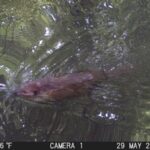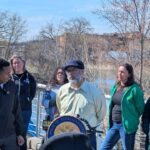Next month’s Amazing Bronx River Flotilla will end up at the spectacular new Concrete Plant Park on the Bronx River between Bruckner Boulevard and Westchester Avenue. Community activism was instrumental in having this abandoned industrial space, the former home of Transit Mix Concrete, reclaimed as a much-needed park. Today the stabilized silos and hoppers of the old plant loom over the park as an iconic backdrop that evokes the Bronx River’s industrial past.
But there are interesting reasons why this concrete plant, like many others, was located beside the southernmost reach of the Bronx River, where since the early 1900s a barge channel was dredged and maintained to serve the needs of industry.
New York City is fortunately situated amidst bountiful natural sources of building materials that are conveniently located alongside water transport routes. For the concrete industry, the western side of the Hudson River up around Rosendale held deposits of dolomite rock which, when processed, yielded some of the finest cement known. Sand, which was mixed with cement to make concrete, came from the other direction. Enormous sand mines located around Port Washington on the north shore of Long Island sent their barge loads up to the Bronx River to meet the cement barges coming down the Hudson.
At the concrete plant, cement and aggregate were drawn off the barges and mixed in the revolving barrels of the familiar cement trucks, which were dispatched to building sites throughout the city. The concrete was mixed en route – this is what is meant by “transit mix” – with the trips carefully timed so as to deliver their loads ready to pour within 60 to 90 minutes. At the construction sites the mixed concrete often joined other building materials that travelled by barge – bricks made of clay dug from the Hudson River’s shores, and trap rock blasted from quarries along the Hudson’s west bank – but these are stories for some other time.
Stephen Paul DeVillo





